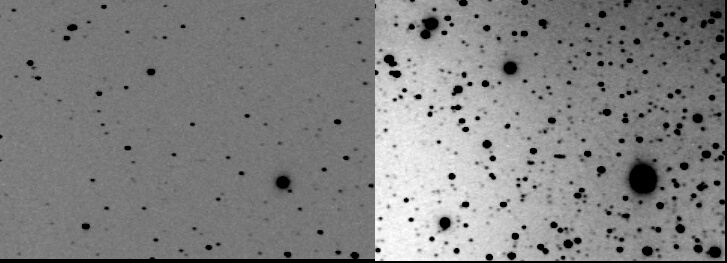
Notes on co-adding images
It is quite straightforward, using CCD's, to obtain very long total exposure times by co-adding short, individual exposures. That is, each frame is translated, as necessary, to have a reference star at the same pixel location in all frames; note that this may require a rotation as well as translation, depending on the circumstances when taking all the exposures.
A number of caveats apply, and a few are given here: that each frame be flat-fielded individually before co-adding (unless there is no translation or rotation between frames); that care be taken that the background (sky) level does not become so large as to reduce the dynamic range of the resulting image (this applies especially to images taken from urban sites); that if photometry of a particular object is the goal, that its image is not saturated in the final image.
Only a very simple example is given here- that of co-adding many short exposures in order to increase the limiting magnitude of the final image. We are not concerned here with maintaining photometric accuracy, just with getting a deep final image. The original images were taken during two nights' of time-series photometry of the suspected CV Librae 3 (see the corresponding web-page for details), and were 80-second exposures with no filter.
In total, 282 of these images were co-added. The location of a field star in the first image was used as the reference point for translation of all images; no rotation was required for any of the images. Each image was flat-fielded before being added, and a constant pixel value of approximately the sky brightness was subtracted from each addition. There was no median-filtering, and no rejection of hot or cold pixels- simply addition. It is to be noted that the flat-field image used was not perfect, and resulted in about a maximum 2% difference in the sky background across each frame. The difference was much smaller, however, across that region of the image containing the "variable" and comparison stars.
The image below shows, on the left, a single 80-second exposure; on the right is a 376-minute (or 22,560-second) equivalent co-added exposure. Both are presented as negatives. Librae 3 is the moderately bright star near the centre, and north is up and east to the left.

The increase in limiting magnitude is considerable. Stars which are at the limit of detection in the single image are very clear in the co-added image, and stars which are, essentially, not detectable in the former are detected in the latter.